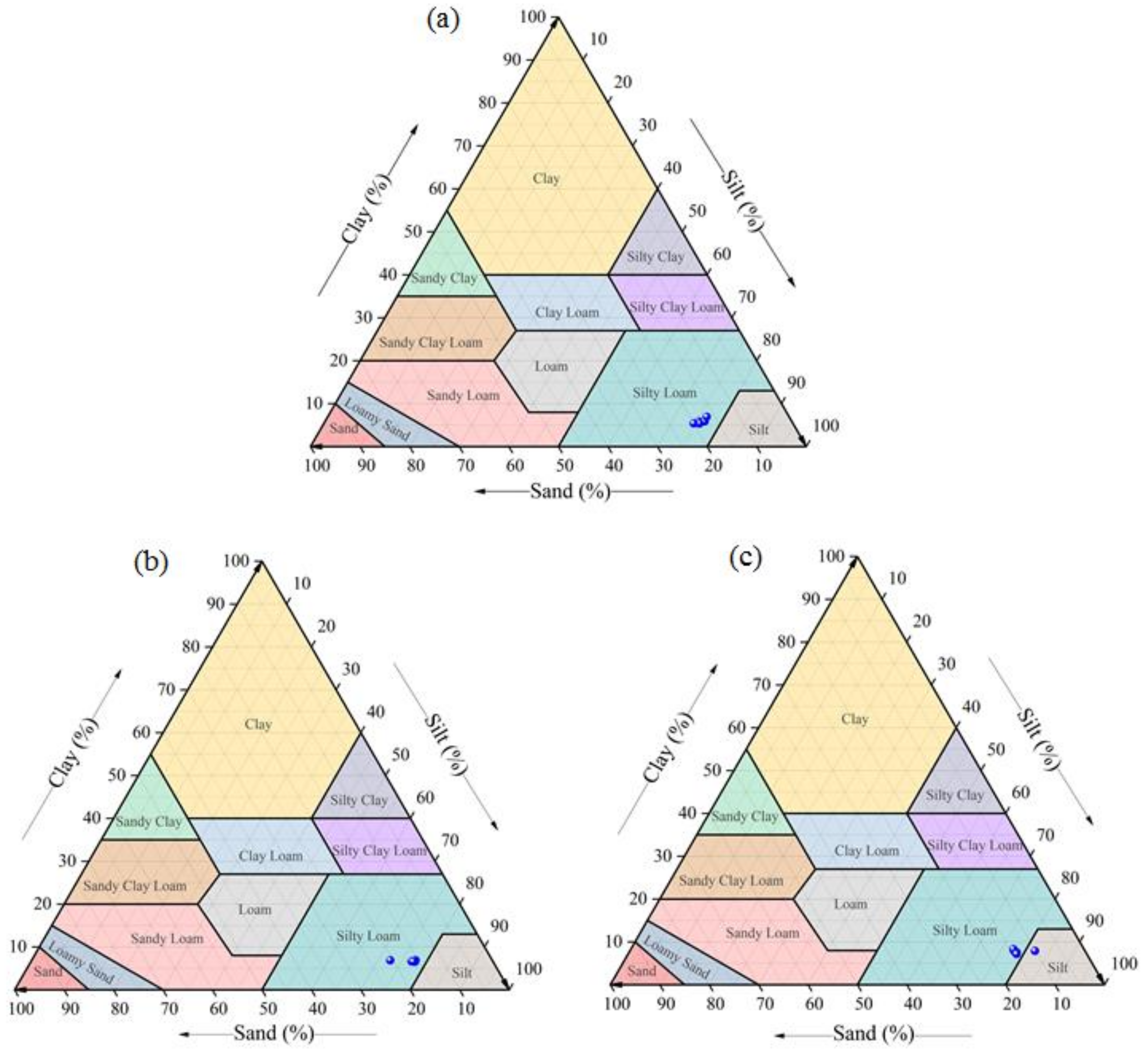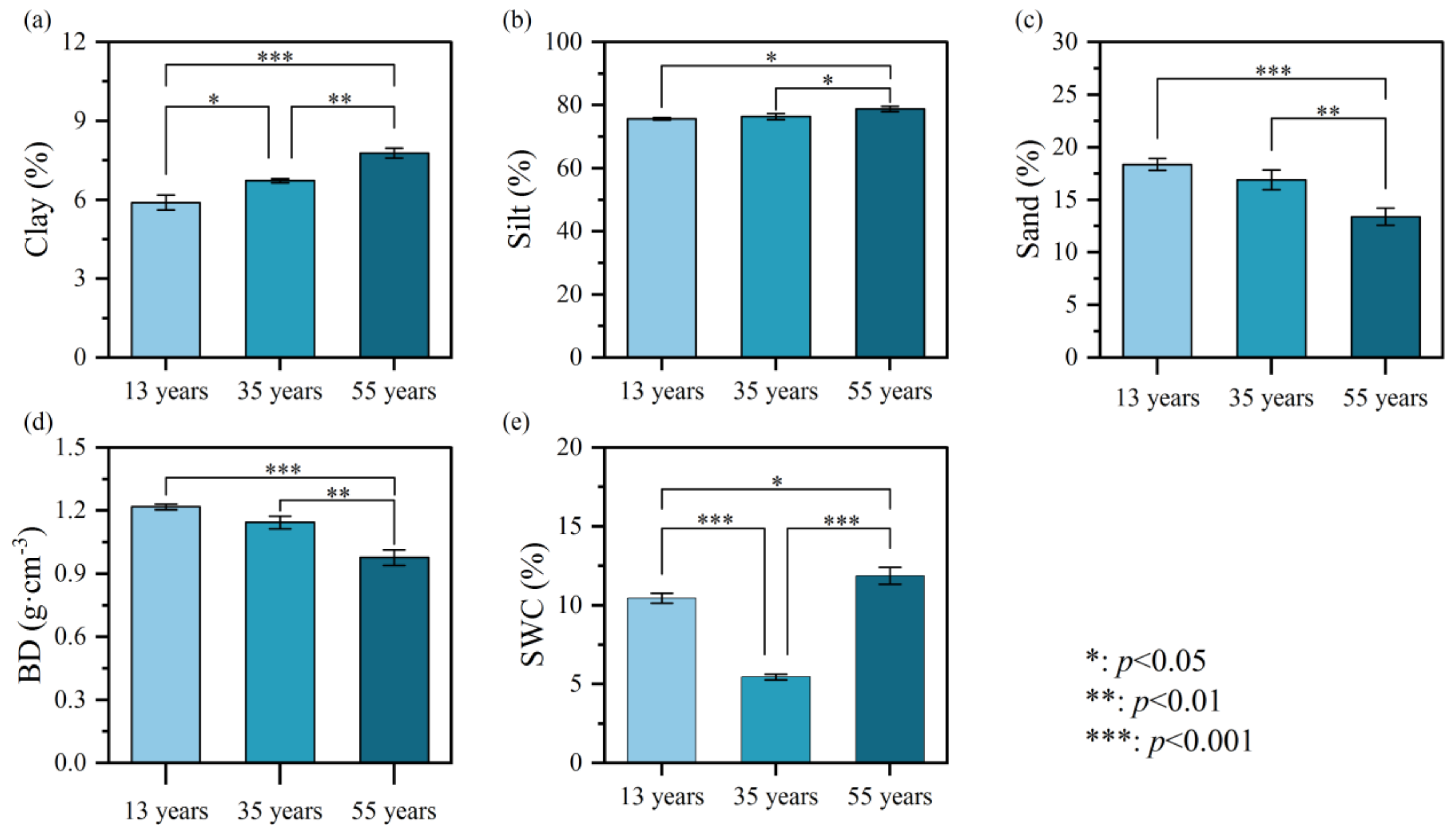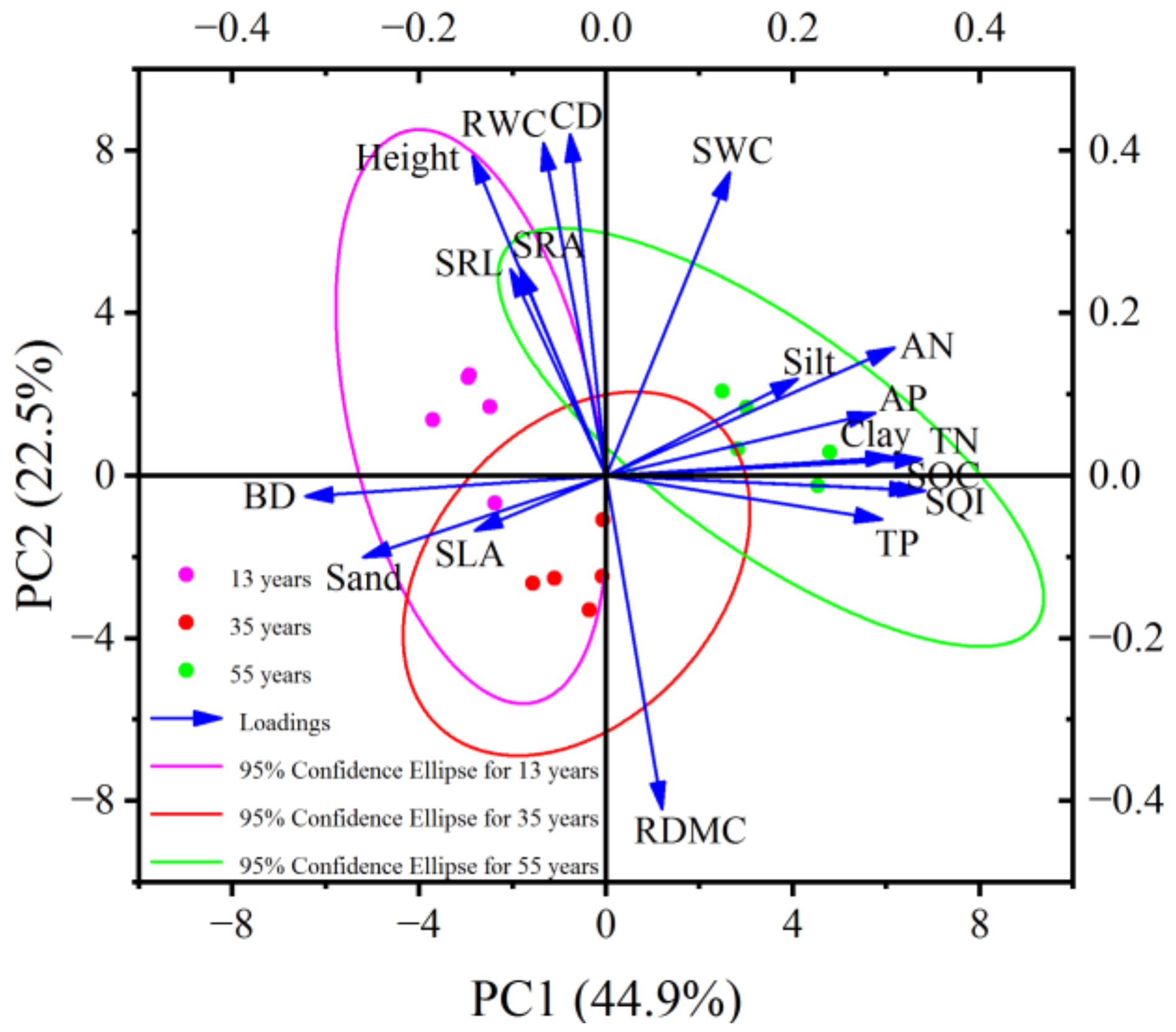Effects of Different Afforestation Years on Soil Properties and Quality
Abstract
:1. Introduction
2. Materials and Methods
2.1. Study Area
2.2. Vegetation Survey and Soil Sampling
2.3. Vegetation and Soil Physicochemical Analyses
2.4. Soil Quality Index
2.5. Statistical Analyses
3. Results
3.1. Vegetation, Leaf, and Root Characteristics
3.2. Soil Physical Properties
3.3. Soil Chemical Properties
3.4. Soil Quality Index
3.5. Principal Component Analysis
4. Discussion
4.1. Effects of Afforestation Years on Vegetation and Root Characteristics
4.2. Effects of Afforestation Years on Soil Physical Properties
4.3. Effects of Afforestation Years on Soil Chemical Properties
4.4. Effects of Afforestation Years on Soil Quality
4.5. Relations between Vegetation, Soil Properties, and Quality
5. Conclusions
Supplementary Materials
Author Contributions
Funding
Institutional Review Board Statement
Informed Consent Statement
Data Availability Statement
Acknowledgments
Conflicts of Interest
References
- Orwin, K.H.; Stevenson, B.A.; Smaill, S.J.; Kirschbaum, M.U.; Dickie, I.A.; Clothier, B.E.; Garrett, L.G.; van der Weerden, T.J.; Beare, M.H.; Curtin, D.; et al. Effects of climate change on the delivery of soil-mediated ecosystem services within the primary sector in temperate ecosystems: A review and New Zealand case study. Glob. Change Biol. 2015, 21, 2844–2860. [Google Scholar] [CrossRef] [PubMed]
- Wang, J.; Zhao, W.; Wang, G.; Yang, S.; Pereira, P. Effects of long-term afforestation and natural grassland recovery on soil properties and quality in Loess Plateau (China). Sci. Total Environ. 2021, 770, 144833. [Google Scholar] [CrossRef] [PubMed]
- Xue, J.; Li, Z.; Feng, Q.; Gui, J.; Zhang, B. Spatiotemporal variations of water conservation and its influencing factors in ecological barrier region, Qinghai-Tibet Plateau. J. Hydrol. Reg. Stud. 2022, 42, 101164. [Google Scholar] [CrossRef]
- Bastida, F.; Zsolnay, A.; Hernandez, T.; Garcia, C. Past, present and future of soil quality indices; a biological perspective. Geoderma 2008, 147, 159–171. [Google Scholar] [CrossRef]
- Hofman, J.; Dušek, L. Biochemical analysis of soil organic matter and microbial biomass composition—A pilot study. Eur. J. Soil Biol. 2003, 39, 217–224. [Google Scholar] [CrossRef]
- John, R.; Dalling, J.W.; Harms, K.E.; Yavitt, J.B.; Stallard, R.F.; Mirabello, M.; Hubbell, S.P.; Valencia, R.; Navarrete, H.; Vallejo, M.; et al. Soil nutrients influence spatial distributions of tropical tree species. Proc. Natl. Acad. Sci. USA. 2007, 104, 864–869. [Google Scholar] [CrossRef]
- Zhang, H.L. Soil quality and sustainable of soil management. J. Soil Water. Conserv. 2002, 16, 119–122. [Google Scholar] [CrossRef]
- Karlen, D.L.; Ditzler, C.A.; Andrews, S.S.; Sposito, G.; Zabel, A. Soil quality; why and how? Geoderma 2003, 114, 145–156. [Google Scholar] [CrossRef]
- Cao, Q.Q. The evolution of soil properties and its influencing factors during the oasis-making processes in the northeastern part of Ulanbuh desert. Ph.D. Thesis, Beijing Forestry University, Beijing, China, 2021; pp. 1–148. (In Chinese). [Google Scholar] [CrossRef]
- Karlen, D.L.; Wollenhaupt, N.C.; Erbach, D.C.; Berry, E.C.; Swan, J.B.; Eash, N.S.; Jordahl, J.L. Crop residue effects on soil quality following 10-years of no-till corn. Soil Till. Res. 1994, 31, 149–167. [Google Scholar] [CrossRef]
- Mairura, F.S.; Mugendi, D.N.; Mwanje, J.I.; Ramisch, J.J.; Mbugua, P.K.; Chianu, J.N. Integrating scientific and farmers’ evaluation of soil quality indicators in central Kenya. Geoderma 2007, 139, 134–143. [Google Scholar] [CrossRef]
- Stavi, I.; Barkai, D.; Islam, K.R.; Zaady, E. No adverse effect of moderate stubble grazing on soil quality and organic carbon pool in dryland wheat agro-ecosystems. Agron. Sustain. Dev. 2015, 35, 1117–1125. [Google Scholar] [CrossRef]
- Mishra, G.; Marzaioli, R.; Giri, K.; Borah, R.; Dutta, A. Soil quality assessment under shifting cultivation and forests in North Eastern Himalaya of India. Arch. Agron. Soil. Sci. 2017, 63, 1355–1368. [Google Scholar] [CrossRef]
- Koga, N.; Shimoda, S.; Shirato, Y.; Kusaba, T.; Shima, T.; Niimi, H.; Yamane, T.; Wakabayashi, K.; Niwa, K.; Kohyama, K.; et al. Assessing changes in soil carbon stocks after land use conversion from forest land to agricultural land in Japan. Geoderma 2020, 377, 114487. [Google Scholar] [CrossRef]
- Hyun, J.; Kim, Y.J.; Kim, A.; Plante, A.F.; Yoo, G. Ecosystem services-based soil quality index tailored to the metropolitan environment for soil assessment and management. Sci. Total Environ. 2022, 820, 153301. [Google Scholar] [CrossRef]
- Jiao, J.; Zhang, Z.; Bai, W.; Jia, Y.; Wang, N. Assessing the Ecological Success of Restoration by Afforestation on the Chinese Loess Plateau. Restor. Ecol. 2012, 20, 240–249. [Google Scholar] [CrossRef]
- Li, M.; Zhou, X.; Zhang, Q.; Cheng, X. Consequences of afforestation for soil nitrogen dynamics in central China. Agric. Ecosyst. Environ. 2014, 183, 40–46. [Google Scholar] [CrossRef]
- Shao, P.; Liang, C.; Lynch, L.; Xie, H.; Bao, X. Reforestation accelerates soil organic carbon accumulation: Evidence from microbial biomarkers. Soil Biol. Biochem. 2019, 131, 182–190. [Google Scholar] [CrossRef]
- Liang, H.; Xue, Y.; Li, Z.; Gao, G.; Liu, G. Afforestation may accelerate the depletion of deep soil moisture on the Loess Plateau: Evidence from a meta-analysis. Land Degrad. Dev. 2022, 33, 3829–3840. [Google Scholar] [CrossRef]
- Li, Y.; Han, C.; Dong, X.; Sun, S.; Zhao, C. Soil microbial communities of dryland legume plantations are more complex than non-legumes. Sci. Total Environ. 2022, 822, 153560. [Google Scholar] [CrossRef]
- Nan, F.; Li, Z.; Zhang, X.; Cui, Q.; Li, Y.; Yang, A.; Xiong, X. Spatial variation of ecological stoichiometry characteristics of hilly soil in Lanzhou section of Yellow River north shore. J. Desert. Res. 2022, 42, 187–196. (In Chinese) [Google Scholar] [CrossRef]
- Li, Y.; Han, C.; Sun, S.; Zhao, C. Effects of Tree Species and Soil Enzyme Activities on Soil Nutrients in Dryland Plantations. Forests 2021, 12, 1153. [Google Scholar] [CrossRef]
- Li, Y.; Dong, X.; Yao, W.; Han, C.; Sun, S.; Zhao, C. C, N, P, K stoichiometric characteristics of the “leaf-root-litter-soil” system in dryland plantations. Ecol. Indic. 2022, 143, 109371. [Google Scholar] [CrossRef]
- Chen, Z.; Wang, G.; Pan, Y.; Yang, X.; Shen, Y. Water use patterns differed notably with season and slope aspect for Caragana korshinskii on the Loess Plateau of China. Catena 2021, 198, 105028. [Google Scholar] [CrossRef]
- Jia, H.K.; Liu, Y.H.; Xu, X.; Wang, K.; Gao, Q. Simulation of soil water dynamics in a caragana intermedia woodland in HuangFuChuan watershed: Relationships among slope, aspect, plant density and soil water content. Chin. J. Plant. Ecol. 2005, 29, 910–917. (In Chinese) [Google Scholar]
- Jia, X.; Wang, X.; Hou, L.; Wei, X.; Zhang, Y.; Shao, M.; Zhao, X. Variable response of inorganic carbon and consistent increase of organic carbon as a consequence of afforestation in areas with semiarid soils. Land Degrad. Dev. 2019, 30, 1345–1356. [Google Scholar] [CrossRef]
- Yang, X.Y.; Li, P.R.; Zhang, S.L.; Sun, B.H.; Chen, X.P. Long-term-fertilization effects on soil organic carbon, physical properties, and wheat yield of a loess soil. J. Plant Nutr. Soil Sci. 2011, 174, 775–784. [Google Scholar] [CrossRef]
- Bryk, M.; Kołodziej, B.; Słowińska-Jurkiewicz, A.; Jaroszuk-Sierocińska, M. Evaluation of soil structure and physical properties influenced by weather conditions during autumn-winter-spring season. Soil Till. Res. 2017, 170, 66–76. [Google Scholar] [CrossRef]
- Li, Q.; Liu, G.B.; Zhang, Z.; Tuo, D.F.; Bai, R.R.; Qiao, F.F. Relative contribution of root physical enlacing and biochemistrical exudates to soil erosion resistance in the Loess soil. Catena 2017, 153, 61–65. [Google Scholar] [CrossRef]
- Biesgen, D.; Frindte, K.; Maarastawi, S.; Knief, C. Clay content modulates differences in bacterial community structure in soil aggregates of different size. Geoderma 2020, 376, 114544. [Google Scholar] [CrossRef]
- Liu, J.X.; Liu, G.B.; Flanagan, D.C.; Wang, B.; Wang, Z.Y.; Xiao, J. Effects of soil-incorporated plant litter morphological characteristics on the soil detachment process in grassland on the Loess Plateau of China. Sci. Total Environ. 2019, 705, 134651. [Google Scholar] [CrossRef]
- Zhang, X.; Zhao, W.; Liu, Y.; Fang, X.; Feng, Q.; Chen, Z. Spatial variations and impact factors of soil water content in typical natural and artificial grasslands: A case study in the Loess Plateau of China. J. Soil Sediment. 2017, 17, 157–171. [Google Scholar] [CrossRef]
- English, N.B.; Weltzin, J.F.; Fravolini, A.; Thomas, L.; Williams, D.G. The influence of soil texture and vegetation on soil moisture under rainout shelters in a semi-desert grassland. J. Arid. Environ. 2005, 63, 324–343. [Google Scholar] [CrossRef]
- Bashkin, M.A.; Binkley, D. Changes in soil carbon following afforestation in Hawaii. Ecology 1998, 79, 828–833. [Google Scholar] [CrossRef]
- Segura, C.; Navarro, F.B.; Jiménez, M.N.; Fernández-Ondoño, E. Implications of afforestation vs. secondary succession for soil properties under a semiarid climate. Sci. Total. Environ. 2020, 704, 135393. [Google Scholar] [CrossRef]
- Li, K.; Ni, R.; Lv, C.; Xue, L.; Zhang, C.; Li, C.; Shen, W.; Guo, H.; Zhang, Y. The effect of Robinia Pseudoacacia expansion on the soil particle size distribution on Mount Tai, China. Catena 2022, 208, 105774. [Google Scholar] [CrossRef]
- Naldini, M.B.; Harguindeguy, N.P.; Kowaljow, E. Soil carbon release enhanced by increased litter input in a degraded semi-arid forest soil. J. Arid. Environ. 2021, 186, 104400. [Google Scholar] [CrossRef]
- Desrochers, A.; Landhausser, S.M.; Lieffers, V.J. Coarse and fine root respiration in aspen (Populus tremuloides). Tree Physiol. 2002, 22, 725–732. [Google Scholar] [CrossRef]
- Deng, Q.; McMahon, D.E.; Xiang, Y.; Yu, C.L.; Jackson, R.B.; Hui, D. A global meta-analysis of soil phosphorus dynamics after afforestation. New Phytol. 2017, 213, 181–192. [Google Scholar] [CrossRef]
- Hussain, S.I.; Phillips, L.A.; Hu, Y.; Frey, S.K.; Geuder, D.S.; Edwards, M.; Lapen, D.R.; Ptacek, C.J.; Blowes, D.W. Differences in phosphorus biogeochemistry and mediating microorganisms in the matrix and macropores of an agricultural clay loam soil. Soil Biol. Biochem. 2021, 161, 108365. [Google Scholar] [CrossRef]
- Li, J.; Xin, Z.; Yan, J.; Li, H.; Chen, J.; Ding, G. Physicochemical and microbiological assessment of soil quality on a chronosequence of a mine reclamation site. Eur. J. Soil Sci. 2018, 69, 1056–1067. [Google Scholar] [CrossRef]
- Zhao, X.; Wu, P.; Gao, X.; Persaud, N. Soil quality indicators in relation to land use and topography in a small catchment on the Loess Plateau of China. Land Degrad. Dev. 2015, 26, 54–61. [Google Scholar] [CrossRef]
- Hunziker, M.; Arnalds, O.; Kuhn, N.J. Evaluating the carbon sequestration potential of volcanic soils in southern Iceland after birch afforestation. Soil 2019, 5, 223–238. [Google Scholar] [CrossRef]
- Segura, C.; Jiménez, M.N.; Fernández-Ondoño, E.; Navarro, F.B. Effects of Afforestation on Plant Diversity and Soil Quality in Semiarid SE Spain. Forests 2021, 12, 1730. [Google Scholar] [CrossRef]
- Liu, L.J.; Gou, G.L.; Liu, J.X.; Zhang, X.B.; Zhu, Q.L.; Mou, J.X.; Yang, R.Y.; Wan, Y.X.; Meng, L.; Tang, S.R.; et al. Effects of Dodonaea viscosa Afforestation on Soil Nutrients and Aggregate Stability in Karst Graben Basin. Land 2022, 11, 1140. [Google Scholar] [CrossRef]
- Raiesi, F.; Kabiri, V. Identification of soil quality indicators for assessing the effect of different tillage practices through a soil quality index in a semi-arid environment. Ecol. Indic. 2016, 71, 198–207. [Google Scholar] [CrossRef]
- Klinerová, T.; Dostál, P. Nutrient-demanding species face less negative competition and plant–soil feedback effects in a nutrient-rich environment. New Phytol. 2020, 225, 1343–1354. [Google Scholar] [CrossRef]
- Håkansson, I.; Lipiec, J. A review of the usefulness of relative bulk density values in studies of soil structure and compaction. Soil Till. Res. 2000, 53, 71–85. [Google Scholar] [CrossRef]
- Mora, J.L.; Lázaro, R. Seasonal changes in bulk density under semiarid patchy vegetation: The soil beats. Geoderma 2014, 235–236, 30–38. [Google Scholar] [CrossRef]







Disclaimer/Publisher’s Note: The statements, opinions and data contained in all publications are solely those of the individual author(s) and contributor(s) and not of MDPI and/or the editor(s). MDPI and/or the editor(s) disclaim responsibility for any injury to people or property resulting from any ideas, methods, instructions or products referred to in the content. |
© 2023 by the authors. Licensee MDPI, Basel, Switzerland. This article is an open access article distributed under the terms and conditions of the Creative Commons Attribution (CC BY) license (https://creativecommons.org/licenses/by/4.0/).
Share and Cite
Yao, W.; Nan, F.; Li, Y.; Li, Y.; Liang, P.; Zhao, C. Effects of Different Afforestation Years on Soil Properties and Quality. Forests 2023, 14, 329. https://doi.org/10.3390/f14020329
Yao W, Nan F, Li Y, Li Y, Liang P, Zhao C. Effects of Different Afforestation Years on Soil Properties and Quality. Forests. 2023; 14(2):329. https://doi.org/10.3390/f14020329
Chicago/Turabian StyleYao, Wenxiu, Fusen Nan, Yage Li, Yuchen Li, Pengfei Liang, and Changming Zhao. 2023. "Effects of Different Afforestation Years on Soil Properties and Quality" Forests 14, no. 2: 329. https://doi.org/10.3390/f14020329




